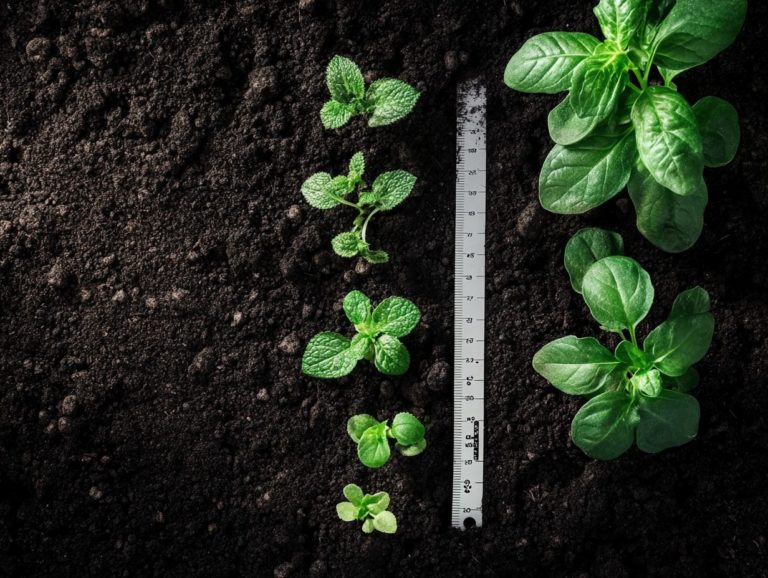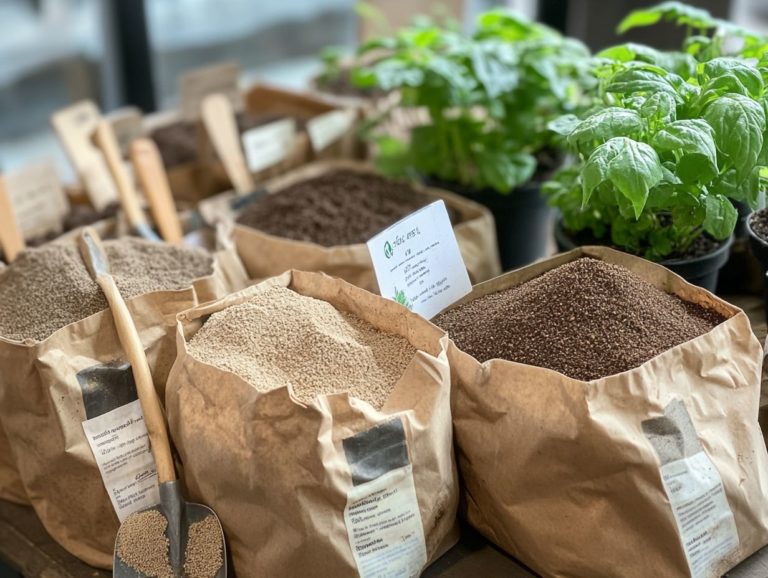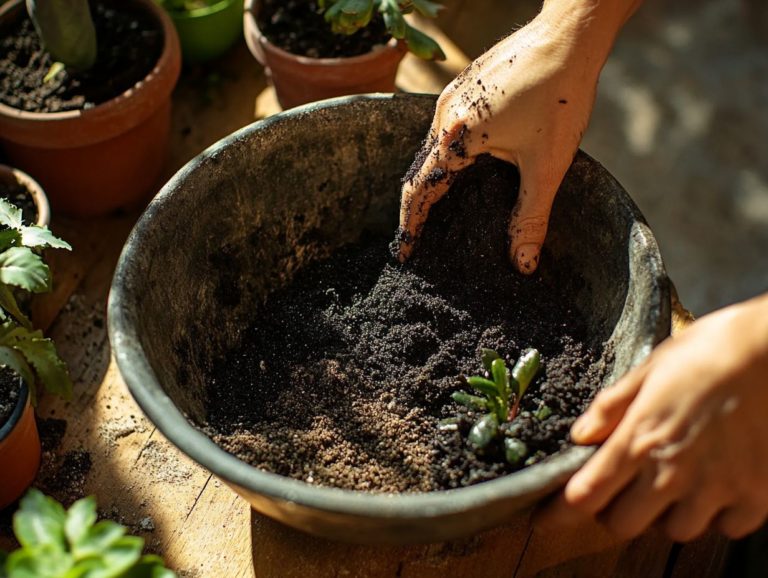The Best Practices for Soil Testing
Soil testing is an essential step for anyone aiming to cultivate thriving plants! Whether you re an experienced gardener or just starting out, grasping the health of your soil can significantly impact your ability to achieve vibrant blooms or plentiful crops.
This article delves into the necessity of soil testing, highlighting the optimal times and methods for conducting tests. It also covers how to interpret the results effectively and offers strategies for correcting nutrient imbalances and selecting the right fertilizers and amendments.
Get ready to discover the secrets that will transform your gardening success!
Contents
Key Takeaways:

- Soils vary in nutrient levels and pH, making testing essential for proper fertilization.
- Test in late winter or early spring for accurate results. Use a soil probe for consistent samples.
- Understanding test results helps improve plant health and yield. Choose fertilizers based on your soil’s needs.
The Importance of Soil Testing
Soil testing is essential for maintaining optimal soil health and fertility, particularly in agricultural practices. Grasping nutrient levels can enhance crop yields and promote sustainability.
Engaging in soil analysis helps you obtain personalized fertilizer recommendations tailored to your unique soil requirements. This effectively addresses any nutrient deficiencies.
Renowned institutions like Michigan State University offer invaluable resources and guidelines for soil testing. These can profoundly impact your nutrient management strategies, ultimately fostering a more productive agricultural landscape.
Why is Soil Testing Necessary?
Soil testing is essential for accurately assessing soil health. This enables you to determine nutrient levels and identify any deficiencies that could hinder plant growth.
Understanding the current state of your soil provides invaluable insights into how to optimize conditions for planting. This process boosts crop yield and guides you in making tailored fertilizer recommendations!
Regular soil sampling allows you to adopt a proactive approach to soil management. This ensures that essential nutrients are readily available for your crops while minimizing the risk of over-fertilization, which is applying too many nutrients that can harm plants.
These assessments can significantly enhance overall soil health, leading to improved biodiversity, increased water retention, and ultimately, a more sustainable agricultural practice.
When and How to Test Your Soil
Understanding when and how to conduct soil testing is crucial. This ensures you achieve precise results and effective nutrient management.
You ll want to ensure that the soil is sampled at the appropriate depth and that the right testing methods are employed to unlock the full potential of your soil’s health and productivity.
Timing and Methods for Soil Testing

Timing your soil testing correctly is vital. Using the right methods can significantly enhance the accuracy of your soil analysis.
Most experts suggest conducting tests before planting to determine the nutritional needs of your soil. This will help you select the right fertilizers and amendments. A post-harvest test can offer invaluable insights into nutrient depletion and guide your strategies for replenishment.
Regarding testing methods, employing a mix of samples from different spots within the area will yield more representative results. It s also essential to maintain an appropriate sampling depth, as different crops may require varying root zones for optimal growth and nutrient absorption.
By following these guidelines, you can ensure a comprehensive understanding of your soil’s health and fertility requirements.
Interpreting Soil Test Results
Interpreting soil test results may seem complex, but it is crucial for effective nutrient management. These results offer valuable insights into nutrient levels, assist in monitoring pH (a measure of how acidic or alkaline the soil is), and highlight potential nutrient deficiencies that could impact crop health.
Understanding these aspects enables you to make informed decisions that promote optimal growth and yield.
Understanding Nutrient Levels and pH
Understanding nutrient levels and pH is essential for effective soil management. These two factors directly impact plant growth and the accessibility of vital nutrients.
A well-balanced soil composition, rich in nitrogen, phosphorus, and potassium, is key to nurturing lush vegetation. However, if the pH swings too high or too low, it can significantly hinder the absorption of these crucial elements.
For example, nitrogen shines at a near-neutral pH, while phosphorus tends to play hard to get in acidic soils. Conducting a soil analysis can reveal any nutrient deficiencies you might face.
If the results show low potassium levels, incorporating potash can help restore balance. Regular adjustments to pH with lime or sulfur can significantly boost nutrient uptake, ensuring your plants receive the nourishment they need to flourish.
Correcting Imbalances in Soil
Correcting imbalances in soil nutrient levels is vital for maintaining the health of your soil and enhancing agricultural productivity. This approach enables you to make informed fertilizer recommendations that specifically address any nutrient deficiencies present in your land.
Methods for Adjusting Nutrient Levels

Adjusting nutrient levels in your soil can be achieved through various methods, such as applying organic matter and adhering to targeted fertilizer recommendations that specifically address nutrient deficiencies.
These strategies can profoundly improve both plant growth and soil health. For example, when you incorporate compost or other organic amendments, you not only enhance the soil structure but also boost its ability to retain nutrients.
By utilizing specific fertilizers informed by comprehensive soil tests, you ensure that your plants receive exactly what they need to flourish. Soil testing allows you to pinpoint deficiencies like nitrogen or potassium, enabling you to apply amendments with precision.
This targeted approach to nutrient management is crucial for maximizing plant productivity while also minimizing the environmental impact typically associated with over-fertilization.
Choosing the Right Fertilizers and Amendments
Selecting the appropriate fertilizers and amendments is essential for cultivating optimal soil health and enhancing nutrient management. Different fertilizers exert distinct influences on soil composition and plant growth, making your choices pivotal for achieving the best results.
Types of Fertilizers and Their Uses
There s a wealth of fertilizers at your disposal, each crafted to deliver essential nutrients like nitrogen, phosphorus, and potassium, all vital for robust plant health. Understanding these options can significantly elevate your gardening success.
Take granular fertilizers, for instance. They provide a slow-release solution, nurturing your plants over an extended period perfect for long-term nutrient management. On the flip side, liquid fertilizers offer immediate nutrient availability, ensuring quick absorption and a rapid boost to plant growth.
Then there are organic fertilizers, derived from natural materials. They not only enhance soil health but also foster beneficial microbial activity. Meanwhile, synthetic fertilizers allow for precise nutrient formulations tailored to specific crop needs. Each type boasts unique benefits, enriching the soil while supporting various agricultural practices.
Organic vs Inorganic Amendments
The decision between organic and inorganic amendments can profoundly influence soil health and managing nutrients in your agricultural practices. Each option presents unique benefits and challenges.
Organic amendments, which come from natural materials like compost, manure, and cover crops, are great for improving soil structure. They also boost microbial activity and enhance long-term fertility.
On the other hand, inorganic amendments usually consist of synthetic fertilizers. They offer the advantage of immediate nutrient availability, allowing for rapid plant uptake. However, be cautious overuse can lead to nutrient leaching and long-term soil degradation.
When it comes to cost, organic options often require a higher initial investment and more labor. In contrast, inorganic materials are typically more budget-friendly and readily available.
Understanding these distinctions helps you make informed decisions that support your soil’s health and productivity, ultimately paving the way for sustainable agriculture.
Frequently Asked Questions

What are the best practices for soil testing?
Best practices for soil testing include:
- Collecting multiple soil samples from the area.
- Avoiding areas with visible contamination.
- Using clean sampling tools and containers.
- Properly labeling and storing samples to ensure accurate analysis.
Why is it important to follow best practices when conducting soil testing?
When you follow best practices, you get accurate results you can trust. This is crucial for making informed decisions about soil management and nutrient supplementation, including choosing the right fertilizers based on nutrient levels.
It also helps avoid contamination and errors that could affect your results.
What is the recommended frequency for conducting soil testing?
For established gardens and agricultural fields, testing is recommended every 2-3 years. For new gardens or areas with significant management changes, consider testing annually for the first few years to monitor soil health and address any nutrient deficiencies.
How should soil samples be collected for testing?
To collect soil samples, use a clean, sharp tool to cut a small slice of soil from the top 6-8 inches of the area. Combine multiple samples to create a representative composite sample.
What factors should be considered when selecting a soil testing lab?
When choosing a soil testing lab, consider:
- The lab’s accreditation and certifications.
- The types of tests offered.
- The turnaround time for results.
- The cost.
Ensure the lab has experience with your specific soil type and local crops, such as those tested by Michigan State University or UMass Soil and Plant Tissue Testing Lab.
How can I interpret the results of a soil test?
To interpret a soil test report, consider the recommended nutrient levels for your specific crop, including pH, nitrogen, phosphorus, and potassium. Seek guidance from the lab or a local agricultural extension office, such as Ohio State or Purdue Extension, on interpreting results and making necessary adjustments to your soil management practices.






